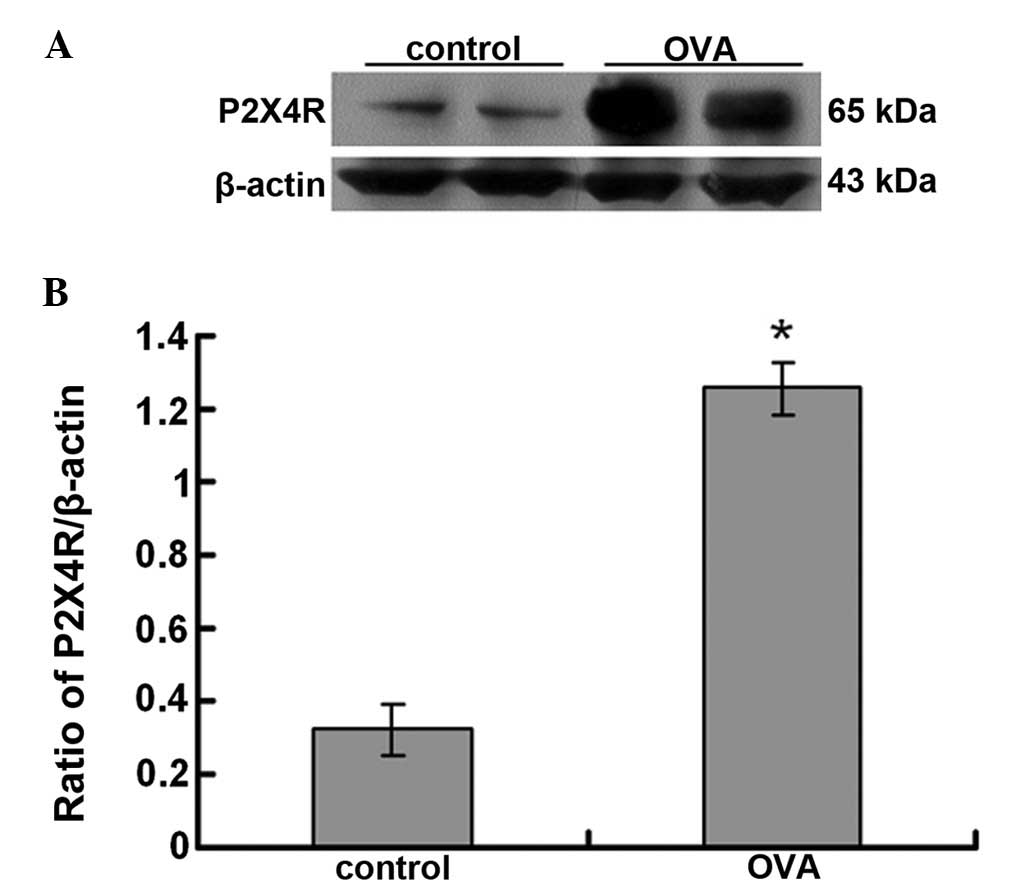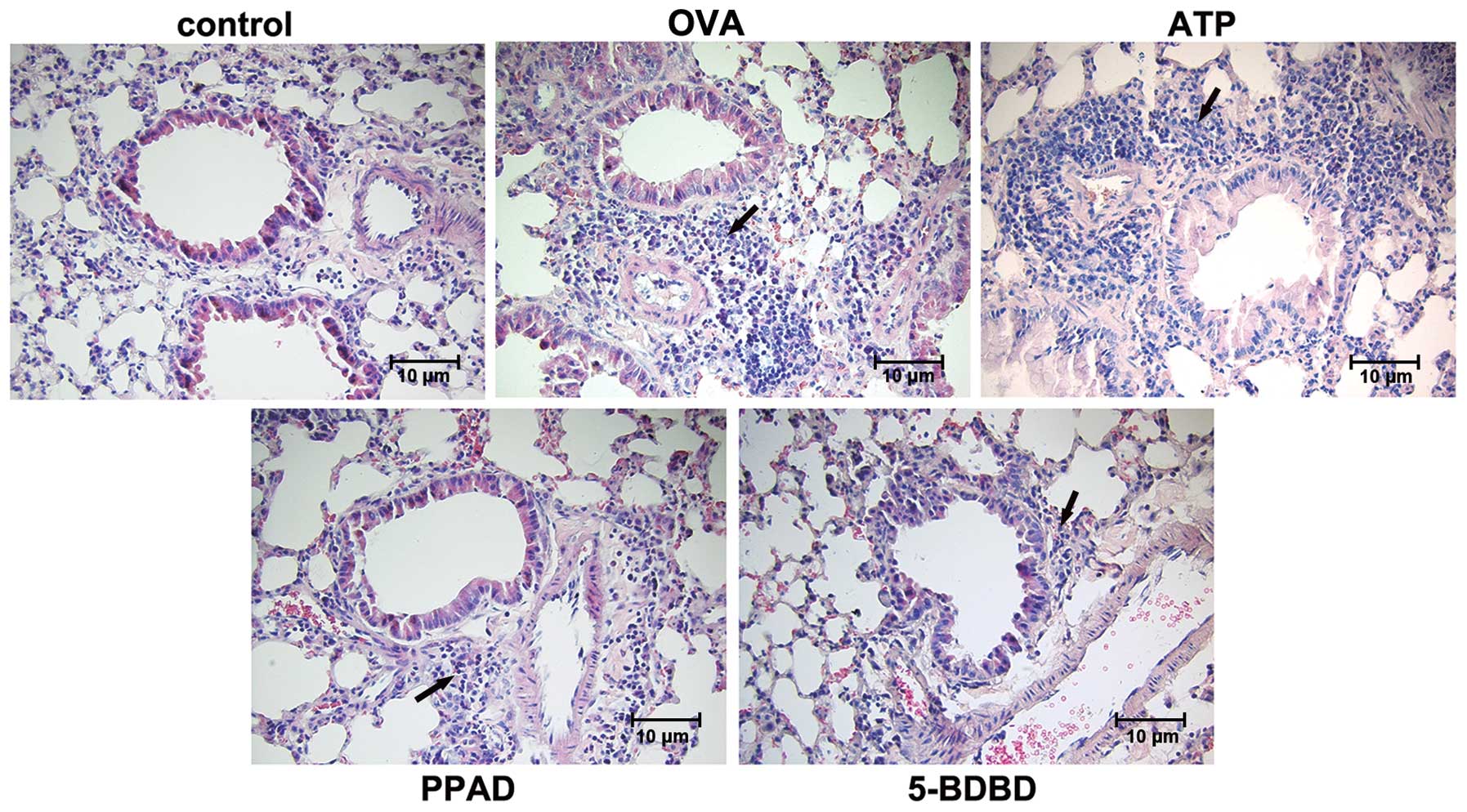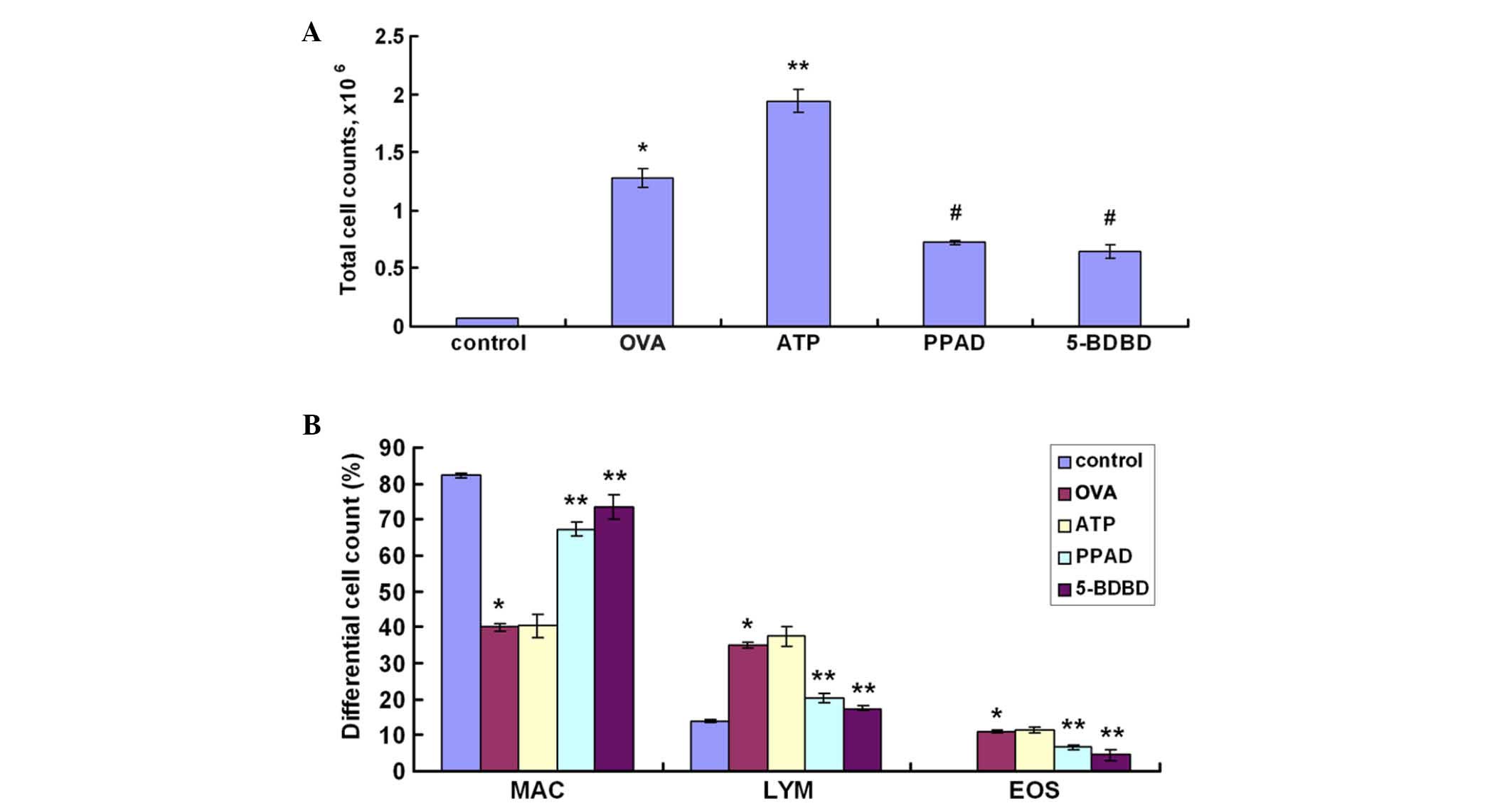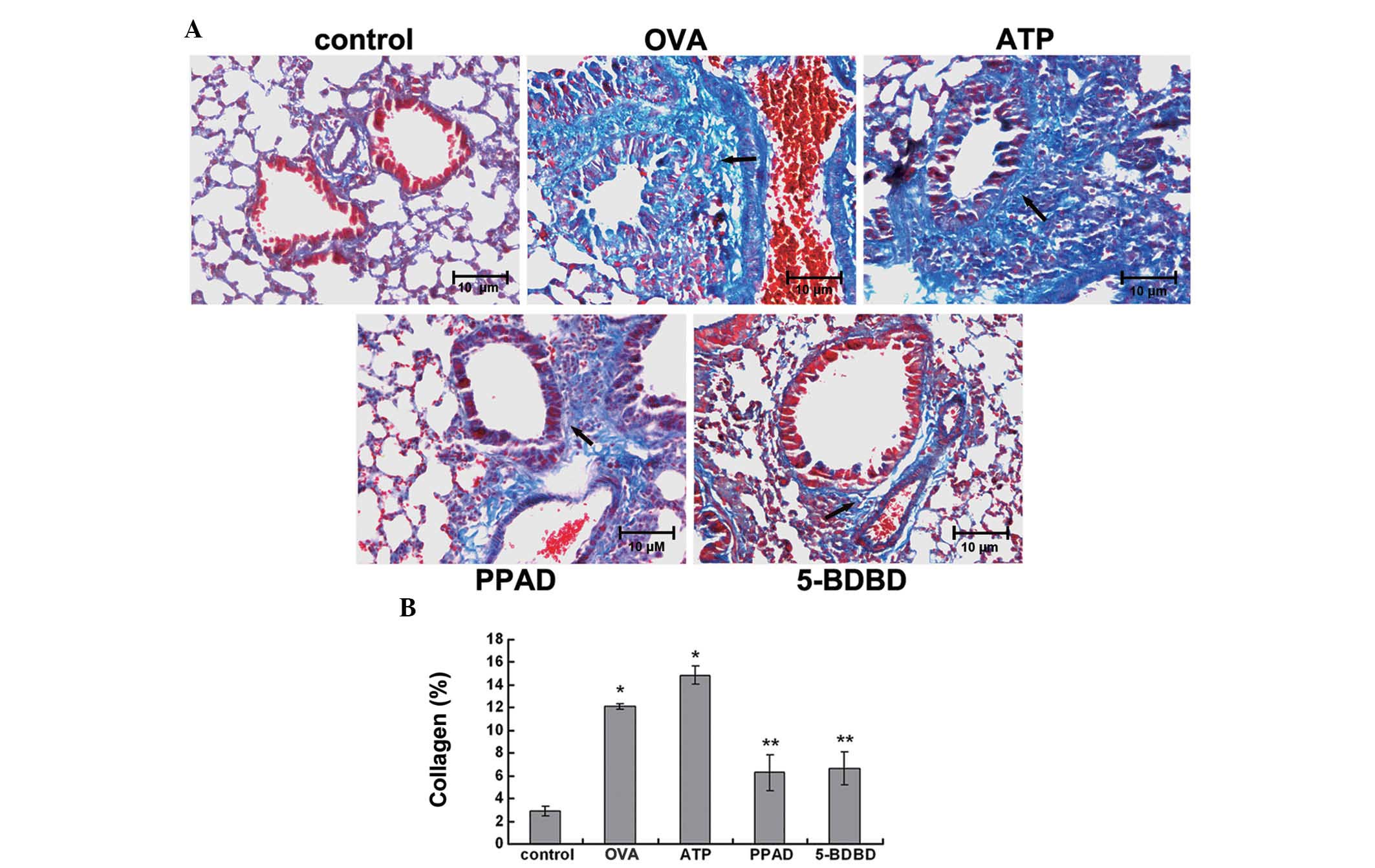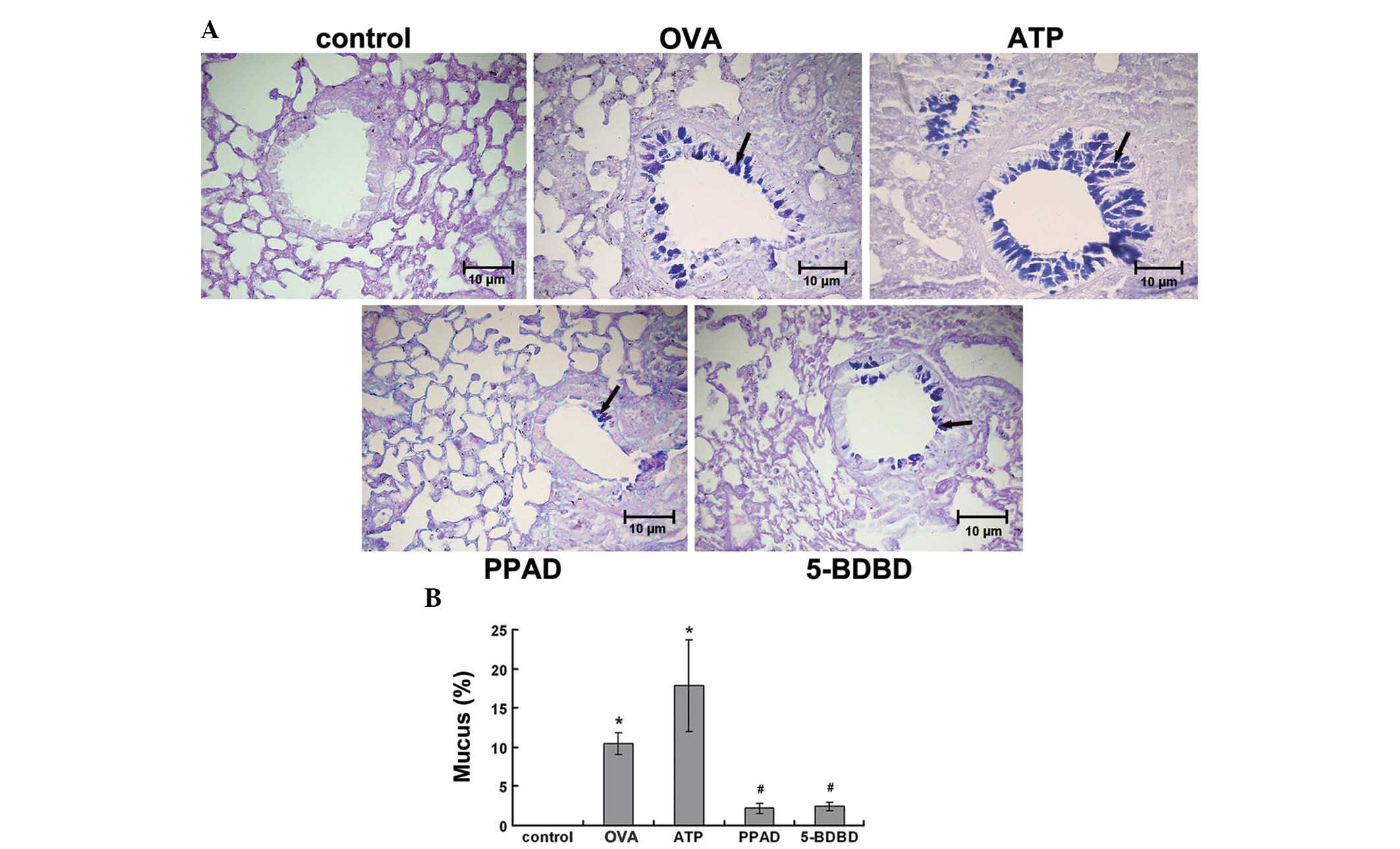|
1
|
Benayoun L and Pretolani M: Airway
remodeling in asthma: Mechanisms and therapeutic perspectives. Med
Sci (Paris). 19:319–326. 2003. View Article : Google Scholar
|
|
2
|
Uhlík J, Simůnková P, Žaloudíková M,
Partlová S, Jarkovský J and Vajner L: Airway wall remodeling in
young and adult rats with experimentally provoked bronchial asthma.
Int Arch Allergy Immunol. 164:289–300. 2014. View Article : Google Scholar : PubMed/NCBI
|
|
3
|
Rhee CK, Kim JW, Park CK, Kim JS, Kang JY,
Kim SJ, Kim SC, Kwon SS, Kim YK, Park SH and Lee SY: Effect of
imatinib on airway smooth muscle thickening in a murine model of
chronic asthma. Int Arch Allergy Immunol. 155:243–251. 2011.
View Article : Google Scholar : PubMed/NCBI
|
|
4
|
Cates C: Inhaled corticosteroids in COPD:
Quantifying risks and benefits. Thorax. 68:499–500. 2013.
View Article : Google Scholar
|
|
5
|
Pascual RM and Peters SP: Airway
remodeling contributes to the progressive loss of lung function in
asthma: An overview. J Allergy Clin Immunol. 116:477–486. 2005.
View Article : Google Scholar : PubMed/NCBI
|
|
6
|
McParland BE, Macklem PT and Pare PD:
Airway wall remodeling: Friend or foe? J Appl Physiol (1985).
95:426–434. 2003. View Article : Google Scholar
|
|
7
|
James AL and Wenzel S: Clinical relevance
of airway remodelling in airway diseases. Eur Respir J. 30:134–155.
2007. View Article : Google Scholar : PubMed/NCBI
|
|
8
|
Royce SG and Tang ML: The effects of
current therapies on airway remodeling in asthma and new
possibilities for treatment and prevention. Curr Mol Pharmacol.
2:169–181. 2009. View Article : Google Scholar : PubMed/NCBI
|
|
9
|
Raissy HH, Kelly HW, Harkins M and Szefler
SJ: Inhaled corticosteroids in lung diseases. Am J Respir Crit Care
Med. 187:798–803. 2013. View Article : Google Scholar : PubMed/NCBI
|
|
10
|
Tagaya E and Tamaoki J: Mechanisms of
airway remodeling in asthma. Allergol Int. 56:331–340. 2007.
View Article : Google Scholar : PubMed/NCBI
|
|
11
|
Warner SM and Knight DA: Airway modeling
and remodeling in the pathogenesis of asthma. Curr Opin Allergy
Clin Immunol. 8:44–48. 2008. View Article : Google Scholar : PubMed/NCBI
|
|
12
|
Roy SG, Nozaki Y and Phan SH: Regulation
of alpha-smooth muscle actin gene expression in myofibroblast
differentiation from rat lung fibroblasts. Int J Biochem Cell Biol.
33:723–734. 2001. View Article : Google Scholar : PubMed/NCBI
|
|
13
|
Stumm CL, Halcsik E, Landgraf RG, Camara
NO, Sogayar MC and Jancar S: Lung remodeling in a mouse model of
asthma involves a balance between tgf-β1 and BMP-7. PloS One.
9:e959592014. View Article : Google Scholar
|
|
14
|
Kesavan R, Potunuru UR, Nastasijević B, T
A, Joksić G and Dixit M: Inhibition of vascular smooth muscle cell
proliferation by gentiana lutea root extracts. PloS One.
8:e613932013. View Article : Google Scholar : PubMed/NCBI
|
|
15
|
Zhao L, Wu J, Zhang X, Kuang H, Guo Y and
Ma L: The effect of shenmai injection on the proliferation of rat
airway smooth muscle cells in asthma and underlying mechanism. BMC
Complement Altern Med. 13:2212013. View Article : Google Scholar : PubMed/NCBI
|
|
16
|
Idzko M, Hammad H, van Nimwegen M, Kool M,
Willart MA, Muskens F, Hoogsteden HC, Luttmann W, Ferrari D, Di
Virgilio F, et al: Extracellular atp triggers and maintains
asthmatic airway inflammation by activating dendritic cells. Nat
Med. 13:913–919. 2007. View
Article : Google Scholar : PubMed/NCBI
|
|
17
|
Khakh BS and North RA: P2x receptors as
cell-surface ATP sensors in health and disease. Nature.
442:527–532. 2006. View Article : Google Scholar : PubMed/NCBI
|
|
18
|
Lommatzsch M, Cicko S, Müller T,
Lucattelli M, Bratke K, Stoll P, Grimm M, Dürk T, Zissel G, Ferrari
D, et al: Extracellular adenosine triphosphate and chronic
obstructive pulmonary disease. Am J Respir Crit Care Med.
181:928–934. 2010. View Article : Google Scholar : PubMed/NCBI
|
|
19
|
Müller T, Vieira RP, Grimm M, Dürk T,
Cicko S, Zeiser R, Jakob T, Martin SF, Blumenthal B, Sorichter S,
et al: A potential role for p2×7r in allergic airway inflammation
in mice and humans. Am J Respir Cell Mol Biol. 44:456–464. 2011.
View Article : Google Scholar
|
|
20
|
Di Virgilio F: Purines, purinergic
receptors and cancer. Cancer Res. 72:5441–5447. 2012. View Article : Google Scholar : PubMed/NCBI
|
|
21
|
Aymeric L, Apetoh L, Ghiringhelli F,
Tesniere A, Martins I, Kroemer G, Smyth MJ and Zitvogel L: Tumor
cell death and ATP release prime dendritic cells and efficient
anticancer immunity. Cancer Res. 70:855–858. 2010. View Article : Google Scholar : PubMed/NCBI
|
|
22
|
la Sala A, Ferrari D, Corinti S, Cavani A,
Di Virgilio F and Girolomoni G: Extracellular ATP induces a
distorted maturation of dendritic cells and inhibits their capacity
to initiate Th1 responses. J Immunol. 166:1611–1617. 2001.
View Article : Google Scholar : PubMed/NCBI
|
|
23
|
Tanaka J, Murate M, Wang CZ, Seino S and
Iwanaga T: Cellular distribution of the P2X4 ATP receptor mRNA in
the brain and non-neuronal organs of rats. Arch Histol Cytol.
59:485–490. 1996. View Article : Google Scholar : PubMed/NCBI
|
|
24
|
Weinhold K, Krause-Buchholz U, Rödel G,
Kasper M and Barth K: Interaction and interrelation of P2X7 and
P2X4 receptor complexes in mouse lung epithelial cells. Cell Mol
Life Sci. 67:2631–2642. 2010. View Article : Google Scholar : PubMed/NCBI
|
|
25
|
Barth K and Kasper M: Membrane
compartments and purinergic signalling: Occurrence and function of
P2X receptors in lung. FEBS J. 276:341–353. 2009. View Article : Google Scholar
|
|
26
|
Wareham K, Vial C, Wykes RC, Bradding P
and Seward EP: Functional evidence for the expression of P2X1, P2X4
and P2X7 receptors in human lung mast cells. British journal of
pharmacology. 157:1215–1224. 2009. View Article : Google Scholar : PubMed/NCBI
|
|
27
|
Inoue K: The function of microglia through
purinergic receptors: Neuropathic pain and cytokine release.
Pharmacol Ther. 109:210–226. 2006. View Article : Google Scholar
|
|
28
|
Ulmann L, Hirbec H and Rassendren F: P2X4
receptors mediate PGE2 release by tissue-resident macrophages and
initiate inflammatory pain. EMBO J. 29:2290–2300. 2010. View Article : Google Scholar : PubMed/NCBI
|
|
29
|
Tsuda M, Kuboyama K, Inoue T, Nagata K,
Tozaki-Saitoh H and Inoue K: Behavioral phenotypes of mice lacking
purinergic P2X4 receptors in acute and chronic pain assays. Mol
Pain. 5:282009. View Article : Google Scholar : PubMed/NCBI
|
|
30
|
Jakobsson PJ: Pain: How macrophages
mediate inflammatory pain via ATP signaling. Nat Rev Rheumatol.
6:679–681. 2010. View Article : Google Scholar : PubMed/NCBI
|
|
31
|
Shen HH, Xu F, Zhang GS, Wang SB and Xu
WH: CCR3 monoclonal antibody inhibits airway eosinophilic
inflammation and mucus overproduction in a mouse model of asthma.
Acta Pharmacol Sin. 27:1594–1599. 2006. View Article : Google Scholar : PubMed/NCBI
|
|
32
|
Vanacker NJ, Palmans E, Kips JC and
Pauwels RA: Fluticasone inhibits but does not reverse
allergen-induced structural airway changes. Am J Respir Crit Care
Med. 163:674–679. 2001. View Article : Google Scholar : PubMed/NCBI
|
|
33
|
Wu T, Dai M, Shi XR, Jiang ZG and Nuttall
AL: Functional expression of P2X4 receptor in capillary endothelial
cells of the cochlear spiral ligament and its role in regulating
the capillary diameter. Am J Physiol Heart Circ Physiol.
301:H69–H78. 2011. View Article : Google Scholar : PubMed/NCBI
|
|
34
|
Krugel U, Schraft T, Regenthal R, Illes P
and Kittner H: Purinergic modulation of extracellular glutamate
levels in the nucleus accumbens in vivo. Int J Dev Neurosci.
22:565–570. 2004. View Article : Google Scholar : PubMed/NCBI
|
|
35
|
Chen K, Zhang J, Zhang W, Zhang J, Yang J,
Li K and He Y: ATP-P2X4 signaling mediates NLRP3 inflammasome
activation: A novel pathway of diabetic nephropathy. Int J Biochem
Cell Biol. 45:932–943. 2013. View Article : Google Scholar : PubMed/NCBI
|
|
36
|
Mauad T, Bel EH and Sterk PJ: Asthma
therapy and airway remodeling. J Allergy Clin Immunol.
120:997–1009. 2007. View Article : Google Scholar : PubMed/NCBI
|
|
37
|
Broide DH: Immunologic and inflammatory
mechanisms that drive asthma progression to remodeling. J Allergy
Clin Immunol. 121:560–570. 2008. View Article : Google Scholar : PubMed/NCBI
|
|
38
|
Bousquet J, Jeffery PK, Busse WW, Johnson
M and Vignola AM: Asthma. From bronchoconstriction to airways
inflammation and remodeling. Am J Respir Crit Care Med.
161:1720–1745. 2000. View Article : Google Scholar : PubMed/NCBI
|
|
39
|
Di Virgilio F: Purinergic signalling
between axons and microglia. Novartis Found Symp. 276:253–258.
2006. View Article : Google Scholar : PubMed/NCBI
|
|
40
|
Donnelly-Roberts D, McGaraughty S, Shieh
CC, Honore P and Jarvis MF: Painful purinergic receptors. J
Pharmacol Exp Ther. 324:409–415. 2008. View Article : Google Scholar
|
|
41
|
Jarvis MF: The neural-glial purinergic
receptor ensemble in chronic pain states. Trends Neurosci.
33:48–57. 2010. View Article : Google Scholar
|
|
42
|
Riteau N, Gasse P, Fauconnier L, Gombault
A, Couegnat M, Fick L, Kanellopoulos J, Quesniaux VF, Marchand-Adam
S, Crestani B, et al: Extracellular ATP is a danger signal
activating P2X7 receptor in lung inflammation and fibrosis. Am J
Respir Crit Care Med. 182:774–783. 2010. View Article : Google Scholar : PubMed/NCBI
|
|
43
|
Chiappara G, Gagliardo R, Siena A,
Bonsignore MR, Bousquet J, Bonsignore G and Vignola AM: Airway
remodelling in the pathogenesis of asthma. Curr Opin Allergy Clin
Immunol. 1:85–93. 2001. View Article : Google Scholar
|
|
44
|
Kudo M, Ishigatsubo Y and Aoki I:
Pathology of asthma. Front Microbiol. 4:2632013. View Article : Google Scholar : PubMed/NCBI
|
|
45
|
Moir LM, Leung SY, Eynott PR, McVicker CG,
Ward JP, Chung KF and Hirst SJ: Repeated allergen inhalation
induces phenotypic modulation of smooth muscle in bronchioles of
sensitized rats. Am J Physiol Lung Cell Mol Physiol. 284:L148–L159.
2003. View Article : Google Scholar
|
|
46
|
Labonté I, Hassan M, Risse PA, Tsuchiya K,
Laviolette M, Lauzon AM and Martin JG: The effects of repeated
allergen challenge on airway smooth muscle structural and molecular
remodeling in a rat model of allergic asthma. Am J Physiol Lung
Cell Mol Physiol. 297:L698–L705. 2009. View Article : Google Scholar : PubMed/NCBI
|
|
47
|
Kim MJ, Turner CM, Hewitt R, Smith J,
Bhangal G, Pusey CD, Unwin RJ and Tam FW: Exaggerated renal
fibrosis in P2X4 receptor-deficient mice following unilateral
ureteric obstruction. Nephrol Dial Transplant. 29:1350–1361. 2014.
View Article : Google Scholar : PubMed/NCBI
|
|
48
|
Soto F, Garcia-Guzman M, Gomez-Hernandez
JM, Hollmann M, Karschin C and Stühmer W: P2X4: An ATP-activated
ionotropic receptor cloned from rat brain. Proc Natl Acad Sci USA.
93:3684–3688. 1996. View Article : Google Scholar : PubMed/NCBI
|
|
49
|
Kellner R, Matzkies F, Sailer D and Berg
G: Potassium substitution in fasting. Z Ernahrungswiss. 16:73–76.
1977.In German. View Article : Google Scholar : PubMed/NCBI
|
|
50
|
Yamamoto K, Sokabe T, Matsumoto T,
Yoshimura K, Shibata M, Ohura N, Fukuda T, Sato T, Sekine K, Kato
S, et al: Impaired flow-dependent control of vascular tone and
remodeling in P2X4-deficient mice. Nat Med. 12:133–137. 2006.
View Article : Google Scholar
|
|
51
|
Ohata Y, Ogata S, Nakanishi K, Kanazawa F,
Uenoyama M, Hiroi S, Tominaga S and Kawai T: Expression of P2X4R
mRNA and protein in rats with hypobaric hypoxia-induced pulmonary
hypertension. Circ J. 75:945–954. 2011. View Article : Google Scholar : PubMed/NCBI
|
|
52
|
Said SI, Hamidi SA and Gonzalez Bosc L:
Asthma and pulmonary arterial hypertension: Do they share a key
mechanism of pathogenesis? Eur Respir J. 35:730–734. 2010.
View Article : Google Scholar : PubMed/NCBI
|















